This is now the third consecutive year that Design Master Software has conducted a survey of engineers and designers in the MEP industry about whether or not they are using building information modeling (BIM) on their projects. This article is a complete overview of all the data we gathered. Some of it interesting, some of it is not. The Use of BIM and 3D Constant Over the Last Three Years article highlights the more interesting observations we have made about the data.
The survey was conducted online. A link to the survey was included in our monthly newsletter, on various LinkedIn groups, on Autodesk’s AutoCAD MEP forum, on AUGI’s Revit MEP forum, and at the bottom of our MEP Ninja comic pages.
Results from the survey in 2010 and 2011 are available online. Comparing this year’s results with those two years, we continue to see two significant trends in the industry:
- The number of projects modeled in 3D for collision detection has not changed in the last two years.
- When a project is modeled in 3D, the number of systems included in the 3D model is increasing.
Demographics
This year, 74 people responded to the survey, 67 of whom were located in the United States or Canada. Like last year, most of the respondents worked at consulting companies and at large companies.
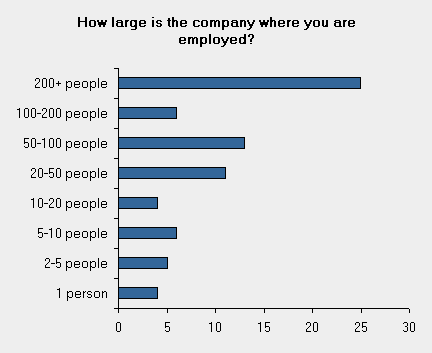
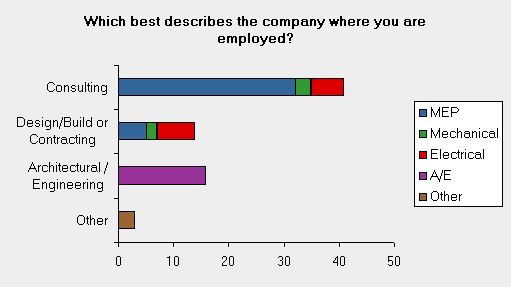
We asked which BIM programs the respondents use. Two-thirds of the respondents in the survey use Revit MEP, half use AutoCAD MEP, and less than half use Design Master (DM) HVAC, Electrical, or Plumbing. There was significant overlap between the three programs, with many respondents using a combination of two or three of the programs. Six respondents did not use any of these three programs. Due to the fact that we sponsored the survey and advertised it in our monthly newsletter, the number of DM users relative to the industry as a whole is probably overstated.


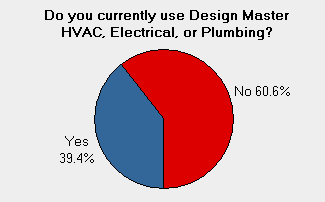
Types of BIM Used
BIM and 3D are not the same thing. You can use BIM for many other purposes, such as automated design, material takeoffs, and green design. We wanted to know how the various types of BIM were being used on projects, not just 3D collision detection (3D-BIM).
We found that 72% of respondents are using 3D-BIM on some of their projects. Only 20% of respondents said that they do not use BIM. Comparing the results from last year with this year, there was an increase in use of BIM for automated design and for material takeoffs. The use of BIM for 3D collision detection and green design did not change.
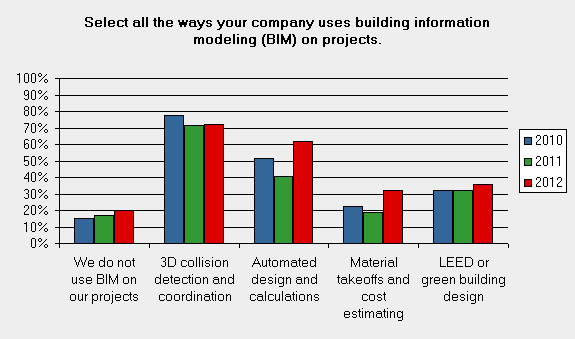
Large firms continue to use BIM more frequently than small firms, though the difference is smaller this year than last year. Large firms use 3D-BIM much more frequently than small firms. Large and small firms continue to use BIM for automated design at the same rate. Large firms use BIM more frequently for material takeoffs, though the use of BIM at small firms for this purpose increased significantly this year. Large firms continue to use BIM more frequently for green design.
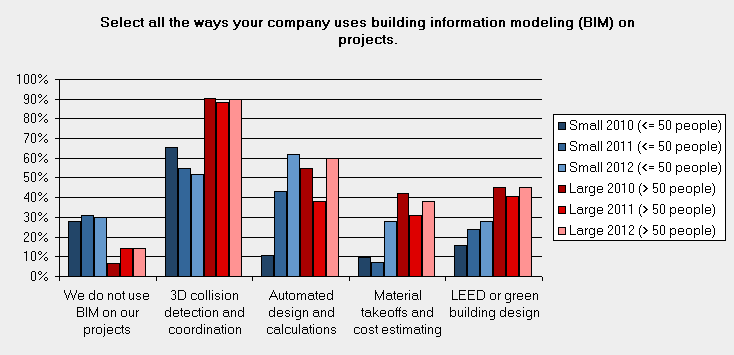
Current Projects Using 3D-BIM
We asked what percentage of current projects use 3D-BIM. For the last two years, 24% of respondents did not use 3D-BIM on any projects. This year, that number decreased to 18%. Similar to last year, 56% of respondents use 3D-BIM on less than half their projects (compared to 62% last year).
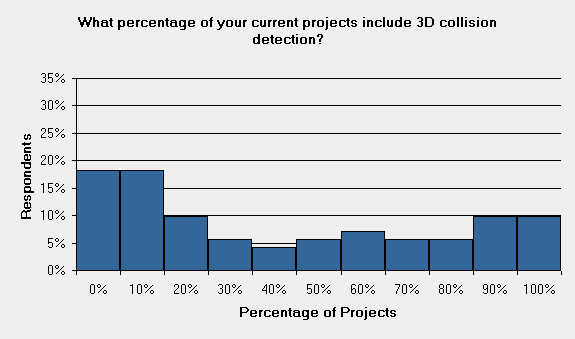
Comparing large firms with small firms again, large firms use 3D-BIM on more of their projects than small firms.
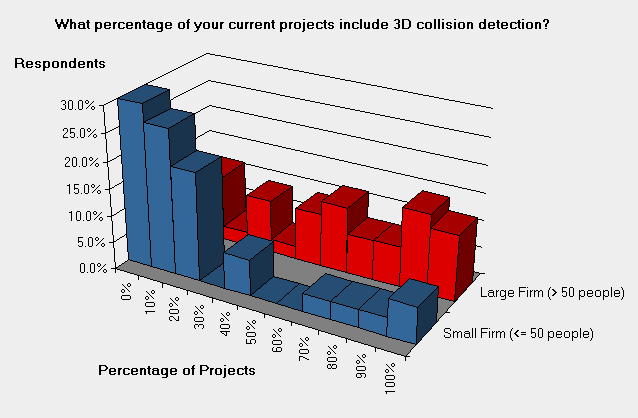
Creating a 3D model and coordinating it with other disciplines is a time-consuming process. We asked whether firms are able to charge for the additional time required on projects that use 3D-BIM. This number continues to bounce around 50% each year. In 2010 it was 40%, in 2011 it was 56%, and this year it is 49%.
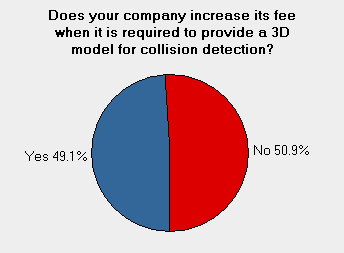
When projects are modeled in 3D, most disciplines are included. Electrical and plumbing models are only slightly less frequently modeled than architectural, structural, and mechanical systems.
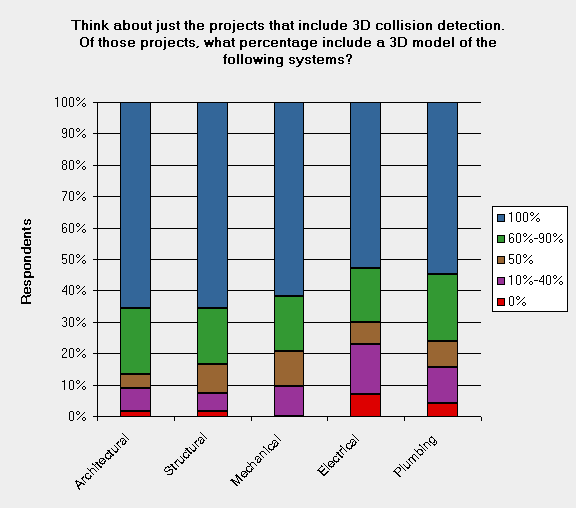
The frequency with which each discipline is modeled in 3D continued to increase compared to last year. In 2010, there were lots of projects modeled in 3D where multiple pieces were not included. In 2011, this increased to include more projects, and in 2012, it increased again to include even more projects. This is where the growth in 3D-BIM is happening. The number of projects that require a 3D model is fairly consistent from year to year. But when a 3D model is called for in a project, everyone is getting on board (whether they want to or not!) to produce one.
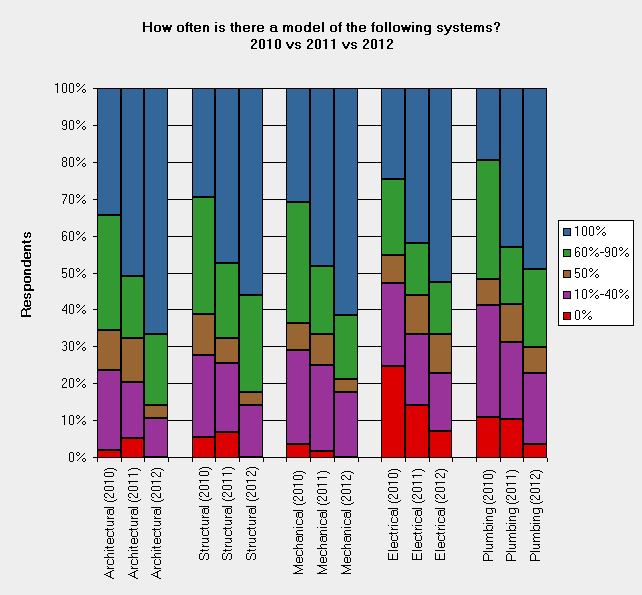
Future Projects Using 3D-BIM
We also asked what percentage of projects in three years would be designed using 3D-BIM. The expectation the last two years was for projects using 3D-BIM to increase, and that expectation is repeated this year. For all three years, 75% of respondents expect to be using 3D-BIM on half or more of their projects in three years, and 30% of respondents expect to be using 3D-BIM on all of their projects in three years.
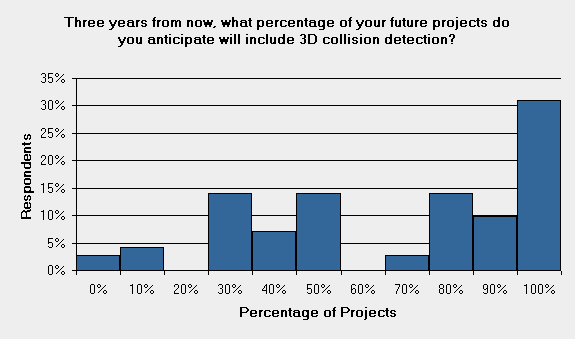
Comparing large firms and small firms again, large firms expect to use 3D-BIM on more projects in 3 years than small firms do. Only 20% of small firms expect all of their work to use 3D-BIM, while 40% of large firms expect that to happen.
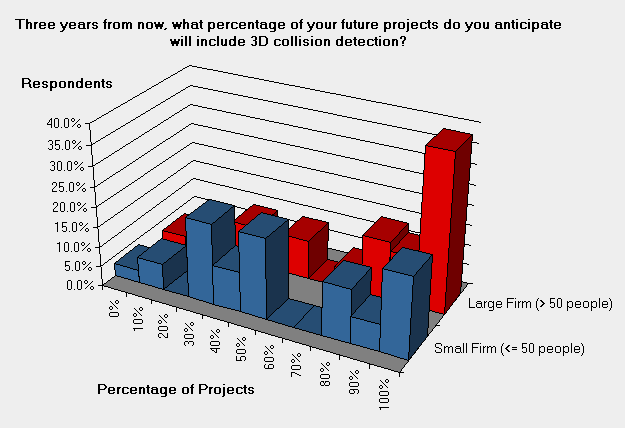
Like the last two years, the expectation is that all disciplines will be modeled in 3D more frequently in the future.
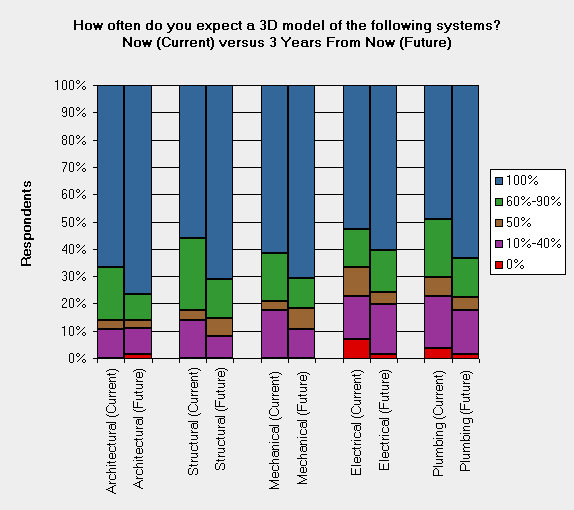
Trends in 3D-BIM
Our original purpose for the survey was to be able to compare trends between years. We now have three years of data and can compare the reported use of 3D-BIM in 2010, 2011, and 2012, and the predicted use of 3D-BIM in 2013, 2014, and 2015. The reported use this year is also one year from the predicted use in the first year of the survey. Has the industry moved toward or away from the predictions for the future use of 3D-BIM?
The current use of 3D-BIM changed very little between 2010, 2011, and 2012. There are differences, but nothing significant compared to the margin of error in the data. The predicted use of 3D-BIM three years in the future also changed very little. The expectations for 2013 in 2010, for 2014 in 2011, and for 2015 in 2012 are basically the same.
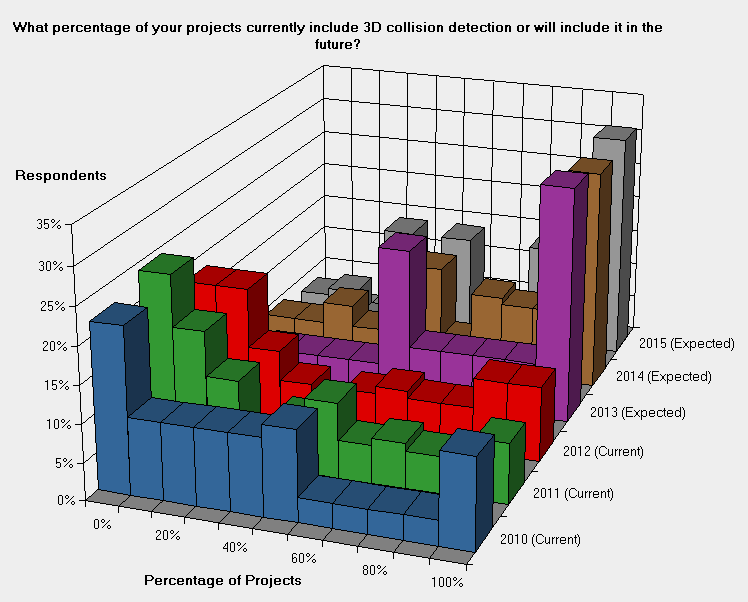
Comparing the current use of 3D-BIM in 2012 and the predicted use of 3D-BIM in 2013, there’s either going to be a huge jump in projects requiring 3D-BIM in the next year, or expectations were wrong. Our hypothesis, which we can finally test next year, is that expectations will prove to be wrong. Widespread use of 3D-BIM will continue to be something that is continually three years away.
The two trends we identified last year continue to hold true this year.
Most projects will not be modeled in 3D. The number of projects using 3D-BIM will slowly increase, but it will not be as dramatic as our respondents expect. High profile projects featured in case studies, such as stadiums, hospitals, and towering skyscrapers, will continue to feature 3D collision detection. Routine buildings that do not benefit from 3D-BIM, such as strip mall remodels, banks, chain restaurants, and veterinarian offices, will not use it. These routine projects that do not require 3D-BIM will outnumber complicated projects that do.
Some projects will be modeled in 3D, and all disciplines will be required to produce a 3D model when this happens. Different parts of the industry have transitioned at different speeds to 3D-BIM. In the next year or two, when a project calls for a 3D model, it will be for the whole project. It will be increasingly unacceptable to have some disciplines not participate in this process.
Recommendations for the FutureGiven these conclusions, what should you do? Here is our advice: Be prepared to provide a 3D model for projects. If you are already working on projects in 3D, that’s great. You are already comfortable with where the industry is heading. If you are not comfortable working in 3D, continue to work toward getting comfortable. At some point, you are going to work on a project where your system is required to be modeled in 3D. When that happens, you need to be ready. Otherwise, you run the risk of losing work to other companies who use 3D-BIM. The specific program you use for this purpose–Design Master MEP, AutoCAD MEP, Revit MEP, or any of the other options–is not important. All can provide the necessary 3D model. What is important is that you are familiar with the program and know where to turn to when you have questions during the process. But don’t forget about projects that do not require 3D-BIM. Make sure you are constantly evaluating and improving your productivity on these other common projects. Hopefully, the same software you use for 3D-BIM includes other BIM features such as automated design calculations that can be used on all of the projects you work on. If not, you need to maintain two workflows, one for your 3D-BIM projects, and one for the your other projects. |
